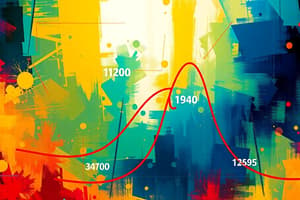Podcast
Questions and Answers
What does the mean of a random variable represent?
What does the mean of a random variable represent?
- A measure of variability in the data
- A precise prediction of future values
- A measure of central location of the random variable (correct)
- An indication of the maximum value in the distribution
What does variance measure in a discrete probability distribution?
What does variance measure in a discrete probability distribution?
- The spread of values around the mean (correct)
- The probability of the most common outcome
- The total number of outcomes in the distribution
- The average outcome of the random variable
What is the relationship between standard deviation and variance?
What is the relationship between standard deviation and variance?
- Standard deviation is the square of the variance
- Standard deviation is the absolute value of variance
- Standard deviation is the positive square root of variance (correct)
- Standard deviation has no relation to variance
When variability is large in a random variable, what can be said about its values?
When variability is large in a random variable, what can be said about its values?
What is the primary purpose of statistics?
What is the primary purpose of statistics?
How is a discrete probability distribution typically presented?
How is a discrete probability distribution typically presented?
Demographic data can include which of the following?
Demographic data can include which of the following?
What does a high value of any measure of variation indicate about a data set?
What does a high value of any measure of variation indicate about a data set?
If a random variable is expected to have 23 inquiries per day, what does this figure represent?
If a random variable is expected to have 23 inquiries per day, what does this figure represent?
How is information from a sample typically used in statistics?
How is information from a sample typically used in statistics?
What is the main purpose of the ratio of standard deviation to mean?
What is the main purpose of the ratio of standard deviation to mean?
What does a probability mass function illustrate?
What does a probability mass function illustrate?
Why is statistical literacy considered essential today?
Why is statistical literacy considered essential today?
What aspect of data does statistical literacy emphasize?
What aspect of data does statistical literacy emphasize?
Which of the following describes the concept of probability?
Which of the following describes the concept of probability?
Which statement is true regarding the expectation of a random variable?
Which statement is true regarding the expectation of a random variable?
Which step is NOT part of solving for the probabilities of outcomes in a random experiment?
Which step is NOT part of solving for the probabilities of outcomes in a random experiment?
Which of the following best describes how statistics is used in decision making?
Which of the following best describes how statistics is used in decision making?
What role does data play in statistical analysis?
What role does data play in statistical analysis?
In the context of probability distribution of discrete random variables, what does $P(x)$ typically represent?
In the context of probability distribution of discrete random variables, what does $P(x)$ typically represent?
Which of the following professions is likely to rely heavily on statistical analysis?
Which of the following professions is likely to rely heavily on statistical analysis?
What does a probability value of $
rac{1}{2}$ indicate when tossing a fair die for an even number?
What does a probability value of $ rac{1}{2}$ indicate when tossing a fair die for an even number?
Which property is true regarding a low value of variability in a data set?
Which property is true regarding a low value of variability in a data set?
When tossing three coins, what is critical to determining the probabilities of outcomes?
When tossing three coins, what is critical to determining the probabilities of outcomes?
What defines quantitative data?
What defines quantitative data?
Which of the following is an example of discrete data?
Which of the following is an example of discrete data?
What type of variable is measured by a continuous scale?
What type of variable is measured by a continuous scale?
What is a characteristic of a variable in statistical analysis?
What is a characteristic of a variable in statistical analysis?
In the context of data collection, what is the purpose of using a survey?
In the context of data collection, what is the purpose of using a survey?
Which of the following is NOT a level of measurement?
Which of the following is NOT a level of measurement?
What does the sample size 'n' refer to in statistics?
What does the sample size 'n' refer to in statistics?
How does continuous data differ from discrete data?
How does continuous data differ from discrete data?
What does the symbol 𝑍 represent in statistical analysis?
What does the symbol 𝑍 represent in statistical analysis?
Which of the following formulas would you use to convert a raw score to a z-score?
Which of the following formulas would you use to convert a raw score to a z-score?
What does 𝜎 represent in the context of probability and z-scores?
What does 𝜎 represent in the context of probability and z-scores?
If you need to compute the probability of a z-score being greater than 2.34, which expression would you use?
If you need to compute the probability of a z-score being greater than 2.34, which expression would you use?
In calculating the z-score, which step involves substituting values into the formula?
In calculating the z-score, which step involves substituting values into the formula?
Why is $P(z = a)$ considered a line without area?
Why is $P(z = a)$ considered a line without area?
Which of the following statements about z-scores is incorrect?
Which of the following statements about z-scores is incorrect?
What does the letter 𝜇 signify in relation to a distribution?
What does the letter 𝜇 signify in relation to a distribution?
Flashcards are hidden until you start studying
Study Notes
Standard Deviation and Mean
- The ratio of standard deviation to mean is unitless and can be expressed in percentage.
- Describes dispersion independent of the measurement unit of the variable.
- High variability in a data set indicates a large measure of variation; low variability suggests consistency.
Probability Outcomes
- Steps to solve probabilities in random experiments include:
- Determining the sample space.
- Finding values of a random variable.
- Assigning probabilities to each random variable value.
- Probability represents the likelihood of an event occurring.
Probability Distribution of Discrete Variables
- Example: Calculating the probability of rolling an even number on a die.
- A discrete probability distribution can be illustrated using a two-row table of assumed values and corresponding probabilities.
Mean and Variance
- Mean of a random variable indicates central location but is not a prediction of an individual outcome.
- Variance measures the spread of values around the mean, indicating variability.
- Standard deviation, the positive square root of variance, helps interpret data distances from expected values.
Statistics Overview
- Statistics involves collection, organization, presentation, analysis, and interpretation of data.
- Data can come from populations or samples and is essential for informed decision-making across various sectors.
- Statistical literacy is crucial for education, government, business, and social sciences.
Variables and Data Types
- Variables can be discrete (countable, e.g., number of subscribers) or continuous (measurable, e.g., height).
- Data refers to facts and figures that are collected and analyzed for insights.
- Quantitative data, e.g., sampling size, can be manipulated mathematically.
Levels of Measurement
- Measurement involves understanding how variables are quantified and typically includes raw scores, population mean, and standard deviation.
- Z-scores standardize data points, allowing comparison across distributions with differing means and standard deviations.
Understanding Z-Scores
- Z-scores help determine probabilities in population and sample data.
- Steps for converting a raw score to a z-score include identifying given data, using the proper z-formula, substituting values, and computing the z-score.
- Z-scores provide a way to measure how far a data point is from the mean in terms of standard deviations.
Practical Application
- Example provided involves assessing the readiness of Grade 12 students for college, demonstrating the application of statistics in educational settings.
- Surveys can be conducted to gather quantitative data, which informs analysis and decision-making processes.
Studying That Suits You
Use AI to generate personalized quizzes and flashcards to suit your learning preferences.




